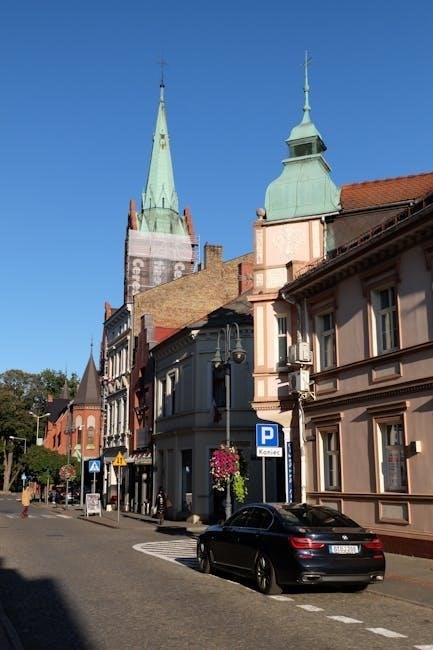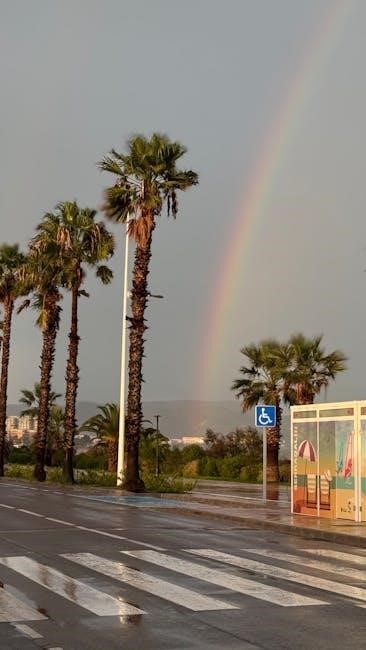Cormac McCarthy’s The Road is a haunting narrative of survival, hope, and the unbreakable bond between a father and son in a desolate, post-apocalyptic world․
1․1 Overview of the Novel
The Road by Cormac McCarthy is a post-apocalyptic novel that follows a father and son as they navigate a devastated world, searching for survival and hope․ Published in 2006, the book is a stark portrayal of a world destroyed by an unspecified cataclysm, where humanity teeters on the edge of extinction․ The father and son journey south, facing moral dilemmas, scarce resources, and constant danger․ McCarthy’s sparse prose captures the harshness of their environment and the depth of their bond․ The novel explores themes of survival, humanity, and the enduring power of love in the face of unimaginable despair․ It won the Pulitzer Prize for Fiction in 2007, cementing its place as a modern literary classic․
1․2 The Author: Cormac McCarthy
Cormac McCarthy is a renowned American novelist, playwright, and screenwriter, celebrated for his profound and often dark exploration of human nature․ Born in 1933 in Rhode Island, McCarthy’s writing style is characterized by sparse, poetic prose and a focus on existential themes․ His works often delve into the harsh realities of life, moral ambiguity, and the search for meaning in a chaotic world․ McCarthy has authored numerous critically acclaimed novels, including No Country for Old Men and Blood Meridian․ The Road, published in 2006, earned him the Pulitzer Prize for Fiction in 2007, further solidifying his reputation as a literary giant․
1․3 The Post-Apocalyptic Genre
The post-apocalyptic genre explores worlds devastated by catastrophic events, often examining humanity’s survival and moral choices in the face of collapse․ These stories frequently depict barren landscapes, scarce resources, and societal disintegration, inviting reflections on resilience, hope, and ethics․ McCarthy’s The Road exemplifies this genre, focusing on a father and son’s journey through a desolate world, emphasizing their bond and struggle for survival․ The genre’s popularity stems from its ability to provoke thought about human nature, community, and the search for meaning in the absence of civilization․ Its themes resonate deeply, making it a powerful lens for exploring existential questions and the human condition․

Plot Summary
The story follows a father and son navigating a barren, post-apocalyptic world, seeking survival and safety, while confronting moral dilemmas and their unbreakable bond․
2․1 The Setting: A Devastated World
The story unfolds in a post-apocalyptic world devoid of vitality and hope․ The once-thriving planet is now a desolate wasteland, scarred by an unspecified cataclysm․ The landscape is barren, with no trees, animals, or signs of life․ A relentless cold grips the environment, and the sky remains perpetually shrouded in a thick, grey haze, blocking sunlight․ The absence of natural beauty creates a haunting atmosphere, emphasizing the severity of the world’s destruction․ The road, a central element, stretches endlessly, symbolizing both the characters’ journey and the futility of their search for salvation․ Resources are scarce, and danger lurks in every encounter, underscored by the constant threat of cannibalism and violence․ This bleak setting mirrors the moral and emotional decay of humanity, heightening the novel’s themes of survival and despair․
2․2 The Journey: Father and Son
The journey of the father and son is the emotional core of The Road․ Driven by the hope of finding safety and humanity in a devastated world, they travel southward, braving unimaginable hardships․ Their relationship is rooted in love, trust, and mutual dependence, as they rely on each other for survival․ The father’s primary goal is to protect his son, while the son represents the last vestige of innocence in a world gone mad․ Their dialogue is sparse yet profound, reflecting the depth of their bond․ The journey serves as a metaphor for the universal struggle between perseverance and surrender, as they confront moral dilemmas and the loss of human decency․ Their shared purpose binds them, offering a glimmer of hope in a despair-filled existence․
2․3 Key Events and Turning Points
The novel is marked by several pivotal moments that shape the narrative․ One of the most significant events is the death of the mother, which occurs early in the story and underscores the bleakness of their world․ The father and son encounter a cannibal group, a harrowing incident that highlights the moral decay of humanity․ Another turning point is their discovery of an underground bunker, which provides temporary refuge and hope․ The father’s health decline and eventual death mark a profound shift, leaving the son alone but determined to carry on․ These events drive the emotional and thematic depth of the story, emphasizing survival, loss, and the enduring bond between father and son․
Major Themes
The novel explores themes of survival, paternal love, morality, and hope amidst despair․ It delves into humanity’s resilience and the struggle between good and evil in a broken world․
3․1 Survival in a Harsh World
In The Road, survival is the dominant theme, as the father and son navigate a barren, post-apocalyptic landscape devoid of resources and hope․ The novel vividly portrays the daily struggle to find food, shelter, and safety in a world overrun by chaos․ McCarthy emphasizes the physical and emotional toll of survival, where every decision is a matter of life and death․ The harsh environment forces the characters to confront their own mortality and the loss of civilization․ Through their journey, McCarthy explores the human will to endure, even in the face of overwhelming despair, highlighting the resilience of the human spirit․

3․2 The Bond Between Father and Son
The bond between the father and son in The Road is the emotional core of the novel, providing a glimmer of humanity in a desolate world․ Their relationship is rooted in trust, protection, and mutual dependence, as they rely on each other for survival․ The father’s unwavering commitment to his son drives their journey, while the son’s innocence and moral curiosity challenge the father to hold onto his humanity․ McCarthy portrays their bond as a source of strength, offering hope amidst the bleakness․ Their interactions reveal the depth of parental love and the resilience of familial ties, even in the face of unimaginable adversity․

3․3 Morality and Humanity in Crisis
In The Road, Cormac McCarthy explores the disintegration of morality and humanity in a post-apocalyptic world․ The absence of societal structures and the constant struggle for survival force characters to confront primal instincts․ The father and son’s journey reveals a stark contrast between those who cling to ethical principles and those who abandon them․ Cannibalism, violence, and exploitation dominate, while the father’s insistence on maintaining humanity—through small acts of kindness and restraint—underscores the fragility of moral codes․ McCarthy raises profound questions about what defines humanity when civilization collapses․ The novel’s bleak landscape mirrors the internal struggle to preserve compassion and justice in a world devoid of hope and order․
3․4 Hope and Despair
In The Road, Cormac McCarthy masterfully juxtaposes hope and despair, creating a poignant exploration of the human spirit․ The father and son’s journey is marked by fleeting moments of hope, such as the boy’s birth before the apocalypse, which symbolizes renewal․ Their relationship becomes a beacon of light in a desolate world, with the father’s unwavering commitment to his son driving their survival․ Yet, despair looms large, as the harsh environment and morally bankrupt encounters erode their optimism․ The novel’s ambiguous ending leaves readers questioning whether hope can endure in a world devoid of civilization․ McCarthy’s portrayal of this fragile balance underscores the resilience of humanity, even in the face of unrelenting despair․
Literary Style and Structure
Cormac McCarthy’s sparse prose in The Road features fragmented sentences, minimal descriptions, and terse dialogue, creating a stark, haunting tone that mirrors the post-apocalyptic world’s desolation and the characters’ relentless struggle․
4․1 McCarthy’s Writing Style
Cormac McCarthy’s writing style in The Road is characterized by sparse, concise prose that reflects the harshness of the post-apocalyptic world․ His sentences are often short and fragmented, creating a sense of urgency and immediacy․ McCarthy avoids elaborate descriptions, instead relying on subtle imagery to convey the desolation and decay of the environment․ The dialogue between the father and son is straightforward and lacking in ornamentation, mirroring their survivalist mindset․ This minimalist approach emphasizes the emotional weight of their journey, allowing the reader to focus on the raw, unfiltered human experience․ McCarthy’s style underscores the novel’s themes of survival, hope, and the enduring bond between parent and child․
4․2 The Use of Sparse Language
Cormac McCarthy’s use of sparse language in The Road creates a stark, haunting atmosphere that mirrors the novel’s post-apocalyptic setting․ His prose is minimalist, with short, direct sentences that avoid unnecessary embellishment․ This Spartan style reflects the harsh, stripped-down world the characters inhabit, where survival is paramount․ The lack of descriptive flourishes or emotional elaboration intensifies the narrative’s emotional impact, forcing readers to focus on the raw, unyielding reality of the father and son’s journey․ McCarthy’s sparse language also underscores the themes of scarcity and desolation, where words, like resources, are used sparingly but powerfully to convey the depth of human struggle and resilience․
4․3 Symbolism in The Road
In The Road, Cormac McCarthy employs symbolism to convey profound meanings about survival, humanity, and hope․ The road itself symbolizes the journey of life, uncertain and fraught with challenges․ The recurring motif of fire represents both destruction and the enduring human spirit, as the father and son keep it alive to preserve their humanity․ The boy embodies innocence and the future, while the desolate, ash-filled landscape mirrors the moral and emotional barrenness of their world․ The cart they push symbolizes the burdens of survival and their relentless forward motion․ McCarthy’s sparse yet powerful symbols reinforce the novel’s exploration of resilience, morality, and the enduring will to survive in a devastated world․
Characters
The novel focuses on two central figures: the father and the son, embodying survival instincts, moral dilemmas, and emotional bonds in a shattered world․
5․1 The Father: A Protector and Survivor
The father is the novel’s central figure, driven by the primal instinct to protect his son in a world devoid of hope․ His actions are dictated by survival, often forcing him into morally ambiguous decisions․ Despite his physical and emotional wear, he remains resourceful, scavenging for food and shelter while shielding his son from the harsh realities of their surroundings․ His unwavering dedication to his child underscores his humanity, even as the world around them crumbles․ The father’s internal struggle between survival and morality highlights his complexity, making him a deeply relatable and tragic figure․
His role as a protector extends beyond physical safety, as he strives to preserve his son’s innocence and instill a sense of morality․ The father’s journey is not just about survival but also about leaving a legacy of humanity in a world teetering on the brink of extinction․ His sacrifices and choices define his character, making him a symbol of resilience and paternal love․
5․2 The Son: Innocence in a Broken World
The son embodies innocence and moral purity in a world stripped of hope․ His youth and naivety contrast sharply with the harsh realities of their post-apocalyptic existence․ Throughout the novel, the son’s curiosity and questions reveal his struggle to understand the remnants of civilization and the absence of humanity․ His presence serves as a reminder of what has been lost and what could still be salvaged․ The son’s moral compass often challenges the father’s pragmatic decisions, highlighting the tension between survival and humanity; Despite the bleakness, the son’s innocence offers a fragile glimmer of hope, symbolizing the possibility of redemption and renewal in a shattered world․
His character underscores the themes of vulnerability and resilience, as he navigates a world devoid of comfort or security․ The son’s interactions with his father reveal a deep emotional bond, emphasizing the importance of human connection in the face of catastrophic loss․ Through his character, McCarthy explores the enduring power of innocence and the potential for humanity to persevere, even in the darkest of times․
5․3 Other Characters: Encounters on the Road
Throughout The Road, the father and son encounter various characters who shape their journey and reveal the depths of human depravity and kindness․ These interactions are fleeting yet significant, often highlighting the moral dilemmas of survival․ For instance, the blind man they meet embodies a lost humanity, while the thief who steals their supplies underscores the brutality of the new world․ These encounters serve as microcosms of the larger themes, showcasing how individuals adapt to the post-apocalyptic landscape․ Each character adds complexity to the narrative, emphasizing the tension between survival and morality․
Other characters, such as the cannibal house they discover, symbolize the complete collapse of societal norms․ These encounters not only heighten the sense of danger but also challenge the father’s resolve to protect his son․ The brief interactions with other survivors illustrate the fragility of human connection in a world devoid of hope, reinforcing the novel’s exploration of humanity’s darkest and most resilient aspects․
Adaptations and Interpretations
The Road has been adapted into a film directed by John Hillcoat, featuring Viggo Mortensen․ It captures the novel’s haunting essence, exploring survival and humanity․
6․1 The Graphic Novel Adaptation
The Road was adapted into a graphic novel in 2010, illustrated by Lee Weeks․ It visually captures the novel’s stark, post-apocalyptic landscape and emotional depth․ Weeks’ artwork emphasizes the father-son bond, conveying the story’s haunting beauty․ The graphic novel stays faithful to McCarthy’s prose while offering a unique visual interpretation․ It appeals to fans of the original novel and introduces the story to new audiences․ The adaptation highlights the universal themes of survival and hope, making it a compelling addition to the story’s legacy․ Its visual storytelling enhances the emotional impact of the narrative, providing a fresh perspective on McCarthy’s timeless tale․

6․2 The Film Adaptation (2009)
The Road was adapted into a film directed by John Hillcoat, starring Viggo Mortensen and Kodi Smit-McPhee․ The movie faithfully captures the novel’s bleak atmosphere and emotional depth, focusing on the father-son relationship; Mortensen’s performance as the father earned widespread acclaim for its raw intensity and vulnerability․ The film’s visual style mirrors the book’s desolate world, emphasizing the characters’ struggle for survival․ While it received critical praise, some noted its unflinching grimness․ The adaptation stayed true to McCarthy’s themes of hope, morality, and the human condition, resonating with audiences․ It serves as a powerful visual companion to the novel, preserving its essence for a broader audience․
6․3 Critical Reception of the Novel
The Road received widespread critical acclaim for its profound exploration of human survival and morality․ Critics praised McCarthy’s sparse, haunting prose, which mirrored the novel’s bleak setting․ The Pulitzer Prize win in 2007 solidified its literary significance․ Reviewers highlighted its emotional depth, particularly the father-son bond, as a beacon of hope in a devastated world․ Some noted its unflinching portrayal of violence and despair, sparking debates about humanity’s resilience․ The novel’s universal themes resonated globally, cementing its status as a modern classic․ Its influence on post-apocalyptic literature is undeniable, with many regarding it as a masterpiece of contemporary fiction․

Study Guides and Resources
Various study guides and resources are available online, offering detailed summaries, analyses, and discussion questions for The Road․ These tools aid in understanding themes, characters, and motifs, enhancing scholarly exploration and classroom discussions․
7․1 Summary and Analysis
The Road by Cormac McCarthy is a haunting exploration of survival, hope, and humanity in a post-apocalyptic world․ The novel follows a father and son as they navigate a barren landscape, seeking safety and meaning․ Themes of survival, morality, and the bond between parent and child are central, with McCarthy’s sparse prose amplifying the emotional intensity․ Analysis often focuses on the symbolism of the road itself, representing both journey and existential struggle․ The novel’s bleakness is offset by moments of tenderness, highlighting the resilience of humanity․ Study guides and analyses provide deeper insights into McCarthy’s style, themes, and the universal relevance of the story in understanding human nature․
7․2 Discussion Questions
Discussion questions for The Road often focus on its themes, characters, and moral dilemmas․ How does the novel portray survival, and what does it reveal about human nature? What role does the father-son relationship play in the story? How does McCarthy’s sparse language contribute to the novel’s tone? What symbols, like the road itself, carry deeper meanings? How does the novel explore hope and despair in a post-apocalyptic world? What moral choices do the characters face, and how do these choices define them? How does the novel comment on humanity’s ability to preserve goodness in crisis? These questions encourage deeper reflection on the novel’s complexities and themes․
7․3 Study Guides Available Online
Study guides for The Road are widely available online, offering in-depth analyses and insights․ Platforms like SparkNotes, LitCharts, and eNotes provide detailed summaries, character analyses, and thematic breakdowns․ These guides explore McCarthy’s sparse prose, the father-son dynamic, and the novel’s exploration of survival and morality․ Many resources include discussion questions, essay topics, and historical context, helping readers understand the post-apocalyptic setting․ Online study guides also examine symbols, such as the road itself, and the novel’s existential themes․ They are invaluable for students and readers seeking to deepen their understanding of McCarthy’s Pulitzer Prize-winning work․ These guides are accessible and offer comprehensive support for studying The Road․

Historical Context
Cormac McCarthy’s The Road reflects post-apocalyptic anxieties, drawing parallels to historical catastrophes and existential crises, influenced by literary movements emphasizing sparse, haunting narratives․
8․1 The Post-Apocalyptic Genre in Literature
The post-apocalyptic genre explores worlds devastated by catastrophic events, examining human survival and societal collapse․ Emerging in the 20th century, it reflects fears of nuclear war, environmental disaster, and pandemics․ Works like George R․ Stewart’s Earth Abides and Walter M․ Miller Jr․’s A Canticle for Leibowitz laid the groundwork․ McCarthy’s The Road stands out for its stark, minimalist portrayal of a father-son journey, emphasizing emotional depth over scientific explanations․ The genre’s evolution mirrors changing global anxieties, with The Road capturing the existential dread of an unspecified cataclysm, resonating with readers seeking meaning in chaos․ Its influence has solidified the genre’s place in contemporary literature․

8․2 McCarthy’s Inspiration for The Road
Cormac McCarthy’s inspiration for The Road stemmed from his fascination with human survival, moral decay, and the bond between parents and children․ He drew from personal experiences, such as traveling through the American Southwest, which influenced the novel’s desolate landscapes․ McCarthy also explored philosophical themes of hope and despair, reflecting his interest in existentialism․ The idea of a father-son relationship enduring in a shattered world was central, inspired by his own role as a father․ McCarthy’s sparse writing style and focus on emotional depth were deliberate choices to convey the story’s gravity․ His unique vision created a haunting yet profound narrative that resonates universally․

Cultural Impact
The Road has left a lasting impact on literature and popular culture, inspiring adaptations and philosophical discussions․ Its exploration of survival and morality resonates globally, shaping contemporary narratives․
9․1 The Novel’s Popularity
The popularity of The Road can be attributed to several factors․ Cormac McCarthy’s reputation as a literary giant and the novel’s Pulitzer Prize win in 2007 significantly enhanced its visibility and appeal․ The story’s focus on a father-son relationship in a post-apocalyptic world resonates deeply with readers, offering both emotional depth and a compelling narrative․ Themes of survival, humanity, and the struggle between hope and despair are universally relatable, making the novel accessible to a broad audience․ Furthermore, the availability of The Road in PDF format has increased its accessibility, allowing more readers to engage with McCarthy’s work․ The novel’s sparse yet powerful language also contributes to its acclaim, making it a standout in contemporary literature․
9․2 Influence on Other Works
The Road has left an indelible mark on literature and popular culture․ Its exploration of survival and human decency in a shattered world has inspired numerous works across media․ The novel’s success prompted a wave of post-apocalyptic narratives in film, literature, and television, with many creators citing McCarthy as an influence․ Its themes of resilience and moral ambiguity have resonated in works like The Walking Dead and other survival stories․ Additionally, the novel’s sparse, haunting prose has influenced writers in the genre, encouraging a more minimalist approach to storytelling․ The availability of The Road in PDF format has further amplified its reach, ensuring its ideas continue to shape contemporary creative endeavors․
The Road by Cormac McCarthy is a modern classic, capturing survival, hope, and humanity in a post-apocalyptic world․ Its timeless message resonates deeply, ensuring its enduring impact and accessibility through its PDF format․

10․1 The Road as a Modern Classic
Cormac McCarthy’s The Road is widely regarded as a modern classic, earning the Pulitzer Prize in 2007․ Its haunting portrayal of a post-apocalyptic world explores themes of survival, hope, and humanity․ The novel’s sparse, poetic prose captivates readers, offering a deeply emotional and philosophical journey․ Its universal appeal lies in its ability to transcend genre, resonating with audiences seeking both literary depth and a gripping narrative․ As a digital text, the PDF format ensures accessibility, allowing readers worldwide to experience this powerful story․ McCarthy’s masterpiece remains a pivotal work in contemporary literature, cementing its place as a timeless classic․
10․2 The Novel’s Timeless Message
The Road delivers a profound and enduring message about humanity’s resilience and the importance of hope, even in the bleakest circumstances․ Through the father-son relationship, McCarthy explores themes of love, morality, and survival, transcending time and context․ The novel underscores the idea that human dignity and compassion can persist despite catastrophic collapse․ Its universal appeal lies in its ability to evoke reflections on existence, ethics, and the enduring human spirit․ As a digital text, the PDF version ensures this poignant message reaches readers globally, reminding them of the strength found in hope and the unbreakable bonds between individuals in the face of unimaginable adversity․
